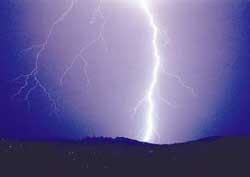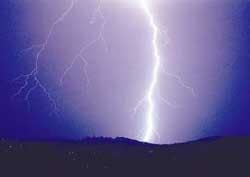Protecting against the power of lightning
Protecting against lightning and power surges is an important aspect of designing communications circuits and systems. Get it wrong and nothing may happen for a long time, but when the time finally does come (and it will), you will certainly know about it. And cleaning up the mess can be a very expensive and time-consuming exercise.
So, if your job entails responsibility for mission-critical communications systems, here's how you can save your installation from potential disaster.
Lightning can be considered as merely the discharge of static electricity build-up in the atmosphere. It is not all that different from the static discharges you seen when you remove an acrylic garment from over a nylon shirt on a dry night. With lightning, of course, the distances and charge build-ups are much greater.
Lightning generally occurs where there is violent warm air movement. It has also been known to occur during volcanic eruptions. Rare accounts also exist for lightning originating from a clear sky. Apart from the common strokes normally seen during a thunderstorm, there are also more esoteric forms, such as ribbon lightning, beaded lightning, and the rare sheet and ball lightning.
In terms of energy, the common lightning stroke is quite phenomenal. The typical peak current in a stroke is around 20,000 amps, with 10% of strokes exceeding 200,000 amps. The stroke to ground can be of either polarity, although negative polarity is the more prevalent. The voltage gradient to ground (i.e., electric field strength) just prior to a stroke can exceed 100 kilovolts (KV) per meter. No wonder people report that hair starts to prickle and stand erect!
Fortunately for us, most strokes occur cloud-to-cloud. Unfortunately, surges induced from these cloud-to-cloud strokes have the potential to inflict serious damage to unprotected nearby communications circuits.
Although somewhat unpredictable in nature, most lightning strokes possess similar attributes. As a result, simulation models for surges induced by lightning onto communications circuits have been developed and generally agreed upon by various international standards bodies. Such models define the standard voltage and current waveform to be used for simulating lightning-induced surges. They also provide recommended designs for electronics circuits required to generate these waveforms.
These simulated waveforms are not the same shape as the waveforms occurring in the lightning stroke itself, but rather represent what you are likely to see induced into a communications circuit as a result of a nearby lightning stroke. By using standard waveforms, protection devices and circuits may be evaluated in a controlled environment and on a level playing field. It also provides the necessary confidence that protection devices will perform the required task under most conditions likely to be encountered in the field.
Lightning-induced surge test waveforms are specified in terms of exponential rise and fall times (in microseconds)-the rise time being specified from 10% to 90% of peak value, and the fall time from peak value of 50% of peak value. For example, an 8/20 waveform is used for induced current, meaning an 8-second rise time and 20-second fall to half the peak value. The peak amplitude is adjusted accordingly to suit the device under test.
It is important to understand that the emphasis on lightning protection is to protect again induced surges rather than direct strikes. The energy contained in a typical lightning stroke is so great and the incidence of direct strike so infrequent that protection against direct strike onto communications cables is generally not viable or necessary.
Surge interference
Surges appearing on communications circuits can be regarded as a type of interference or noise, albeit harmful and sometimes injurious. The mechanisms for coupling onto communications circuits are identical to that of other types of interference-the main differences being that the levels are usually high and duration is generally short.
The effect of surges can be to cause human injury; to cause physical damage to the cable and/or terminating equipment, and to prevent the circuit from functioning correctly for the duration of the surge. Interference can couple to communications circuits by means of electric field coupling (electrostatic induction); magnetic field coupling (electromagnetic induction); and, direct contact (conduction). Different protection or alleviation methods apply to each.
Induced surges have different properties compared to surges caused by direct contact. In particular, surges induced into twisted pair communications circuits will always be induced in the common or longitudinal mode. This means that the surge voltage (and current) induced on each leg of the circuit pair will be roughly the same in amplitude and polarity.
As the surge travels away from the source of induction and along the circuit in both directions, the physical irregularities and imperfections in the cable pair will convert some of this longitudinally-induced surge to a differential voltage. If the terminating equipment at each end of the circuit is not well-balanced, it too will convert some of the surge to a differential mode signal.
For induced surges, the longitudinal surge will cause most of the damage, if of sufficient amplitude. The differential mode surge signal will cause interference, preventing the circuit from functioning for the duration of the surge, and possibly also cause damage if of sufficient amplitude.
Direct lightning strikes onto communications cables are relatively rare, however, conducted interference onto communications cable circuits arise more frequently from nearby strikes to ground. When lightning strikes the ground, very large currents flow away from the strike point, both along the surface and into the ground. Obviously, paths of least resistance are favored.
The strike current sets up an enormous potential rise gradient area in the vicinity of the strike (remember that typical peak currents around 20,000 amps can be expected, and the ground is usually not all that conductive). This gradient area diminishes with distance away from the strike point.
Unfortunately, a communications cable passing through such a high-voltage gradient area may easily break down, since different parts of the cable will be at vastly different potentials (outdoor telecommunications cable sheaths typically have a breakdown strength of around 20 to 30 KV, and the individual conductors within 3 to 5 KV, depending on the cable type). The net result of such breakdown will be to conduct some of the lightning current away along the affected communications circuits. Also, the amount of current entering each leg of each pair may well be very different, depending on which conductors break down first.
In such instances, the cable will usually suffer permanent sheath damage, as well as probable carbon tracking between conductors inside. Future immersion in rain may cause further damage, depending on cable type (filled or unfilled, pressurized, etc.) and the severity of the sheath damage.
Surge protection techniques
Surge protection can be accomplished by shielding (for induced surges) and/or by fitting protection devices at appropriate points along each circuit. Regarding shielding, it is usually only cost-effective to provide electrostatic shielding on cables. This is achieved simply by providing a conductive foil that envelops all pairs within the cable. The grounding of this foil at one end of the cable run provides an effective electrostatic screen.
Effective electromagnetic shielding is much more difficult to achieve-the cable requiring either some form of enveloping ferromagnetic material (such as steel tape armoring), or a very low resistance conductive sheath that is well-grounded at regular intervals.
Surge protection devices generally fall into two classes-primary and secondary. A primary protection device is designed to be fitted near the input terminals of the terminating equipment. Its function is to direct the bulk of any incoming surge energy to ground. It is common practice to use some form of gas arrester for primary protection applications. A gas arrester is a gas discharge device designed to conduct when the voltage between two terminals exceeds a specific design limit.
Common firing voltage values for gas arresters intended for use in communications circuits are 90V, 230V, 350V and 500V. Arresters for communications applications are commonly available as either two-electrode or three-electrode types.
For balanced pair applications, it is important to use the three-electrode type, which is essentially two two-electrode devices in a single package. It has two circuit terminals and a center ground terminal, all fitted to a common gas chamber. If either side fires, the discharge spreads rapidly to the other side, thereby maintaining circuit balance and quenching the surge on both legs of the circuit as quickly as possible.
GEORGE GEORGEVITS manages Power & Digital Instruments Pty. Ltd. (PDI), Australia, which specializes in lab- and field-testing of cabling systems and components, electronics design, and troubleshooting. This article is reprinted from our sister publication, Cabling Installation & Maintenance Australia-New Zealand.

